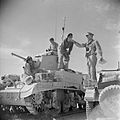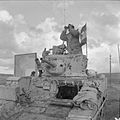Stuart tank
Перейти до навігації
Перейти до пошуку
English: The Stuart was an American light tank of World War II used by both U.S. and British forces, among others. The "Stuart" name, coined by the British, comes from the Civil War general Jeb Stuart and was used for both the M3 and M5 light tanks. To the U.S. Army the tanks were officially known as Light Tank, M3 and Light Tank, M5.
English: The M3 Stuart, introduced in 1941, was the earliest Stuart version. The British called it the Stuart I or Stuart II, depending on whether it had a gasoline or diesel engine. The M3 was developed from the preceding M2A4 light tank by thickening the armor, redesigning the main gun's recoil compensator so that it no longer protruded from the turret, and altering the suspension so that the rear idler wheel rested on the ground, reducing the tank's ground pressure. Unlike later Stuart versions, the M3 had a turret with a cupola for the commander, and its side sponsons held machine guns that were aimed and fired by the tank's driver. (Some late M3s had a newer turret without a cupola which was also used on the M3A1.)
-
The M3 Stuart. This early production version has an octagonal turret and hexagonal cupola.
-
The British 8th Hussars testing their new M3 Stuarts in the Western Desert, 28 August 1941.
-
Equipment and crew of an M3 Stuart at Fort Benning, Georgia, 18 December 1941.
-
Front view of M3 Stuart with hatches open at Fort Benning, 18 December 1941.
-
Two Japanese Army soldiers pose with a captured U.S. M3 Stuart near Manila, Philippines in January 1942.
-
M3 Stuart training at Fort Knox, June 1942.
-
A Soviet M3 Stuart (supplied through Lend-Lease) with a towed gun, captured at the Second Battle of Kharkov, May 1942.
-
An officer of the Royal Tank Regiment gives orders to a British M3 Stuart commander in the Western Desert, 18 June 1942.
-
A signalman signaling from atop a U.S. Marine Corps M3 Stuart during maneuvers in 1942. (This is a late M3 without a cupola on the turret.)
-
A Marine Corps M3 Stuart on Guadalcanal in late 1942.
-
An Australian-manned M3 Stuart busts Japanese pillboxes in the final assault on Buna, Papua, 2 January 1943.
-
A British M3 Stuart in Italy about to have an engine change at a REME workshop, 7 November 1943.
-
A restored M3 Stuart in Kradolf, Switzerland in 2010.
English: The M3A1 Stuart, introduced in 1942, was the successor to the M3. The British called the gasoline-engined version the Stuart III and the diesel one the Stuart IV. The M3A1 had a new turret without a cupola; unlike the M3's turret, which was traversed by hand, that of the M3A1 had power traverse. The sponson machine guns were eliminated from the M3A1.
-
The M3A1 Stuart.
-
A soldier places a simulated satchel charge on the bogie of an M3A1 Stuart during U.S. Army maneuvers in Tennessee in 1942.
-
Two U.S. Marines being trained in an M3A1 Stuart at Montford Point Camp, North Carolina, April 1943.
-
A British M3A1 Stuart with British infantry in Grazzanise, Italy, 12 October 1943.
-
An M3A1 Stuart bogged down during the Battle of Makin in the Gilbert Islands in November 1943.
-
An M3A1 Stuart of the British Indian Army passes a wrecked Jeep near Mandalay, Burma, on 19 March 1945.
-
An M3A1 Stuart in U.S. Army markings with veterans at 2013 D-Day commemorations in Sainte-Mère-Église, Normandy.
English: The M3A3 Stuart, introduced later in 1942, was the last model of the M3 line. The British called it the Stuart V. The M3A3 had a greatly modified hull, much like that of the M5 Stuart (see below) which had been introduced slightly earlier. Previous M3 versions had a hull with a low front, the superstructure beginning just underneath the turret. The new hull for the M5 and M3A3 rose more steeply in front, providing more internal space. On the M3A3 the hull had inward sloping sides and a flat rear deck. The M3A3 also had a lengthened turret with a rear extension for a radio compartment. This M3 version was not used by U.S. forces, instead being supplied to U.S. allies.
-
The M3A3 Stuart, showing the expanded hull, extended turret, and flat rear deck.
-
Turret assembly of the M3A3 Stuart, showing the basket which holds the turret crew.
-
A British M3A3 Stuart of the 8th Hussars in Normandy on 15 June 1944.
-
French children climb aboard a Free French M3A3 Stuart on 23 August 1944.
-
M3A3 Stuart tanks of the Yugoslav Partisans heading to Trieste in May 1945.
-
Another view of the M3A3 in Belgrade, showing the sloping of the hull sides.
-
An M3A3 Stuart at the Republic of China Army's Armor School History Museum in Hukou, Taiwan in 2013.
English: The M5 Stuart, introduced in early 1942 and dubbed Stuart VI by the British, was a new Stuart version powered by twin V8 automobile engines. M3 series Stuarts had used radial airplane engines, and war demands made these engines hard to obtain. The M5's hull was also redesigned, with a uniformly sloping front, flat sides, and an elevated rear deck to make room for the new engines. (This also formed the basis for the M3A3's hull.) The original M5 had a relative short turret, which would be extended in the later M5A1 (see below).
-
The M5 Stuart, showing its redesigned hull, elevated rear deck, and short turret.
-
An M5 Stuart in U.S. Army markings on display in Redwood City, California in 2010.
-
A front view of the M5 Stuart in Redwood City.
-
Closeup of the turret on the M5 Stuart in Redwood City.
English: The M5A1 Stuart, introduced in late 1942, was the final Stuart version. (The British used their Stuart VI designation for this version as well, not distinguishing it from the original M5.) The M5A1 was a modified M5 with the same extended turret as on the M3A3. This turret had an anti-aircraft machine-gun mount on its right side, rather than on the rear as on previous Stuarts. On late versions of the M5A1 there is a curved shield covering this mount.
-
US M5A1 Stuarts pass through the wrecked streets of Coutances, Normandy.
-
American M5A1s move through Avranches (Manche), France.
-
M5A1 at Cape Gloucester.
-
M5A1 in Europe, 1944.
-
M5A1 in Europe, 1944.
-
M5A1 Light tank in Worthington Tank Museum, Canada.
-
M5A1 Light tank in Worthington Tank Museum, Canada.
-
M5A1 Light tank in Worthington Tank Museum, Canada.
-
M5A1 Light tank in Worthington Tank Museum, Canada.
-
M5A1 Light tank in Worthington Tank Museum, Canada.
-
M5A1 in Yad la-Shiryon Museum, Israel.
-
M5A1 in Yad la-Shiryon Museum, Israel.
-
M5A1 Light Tank.






















































